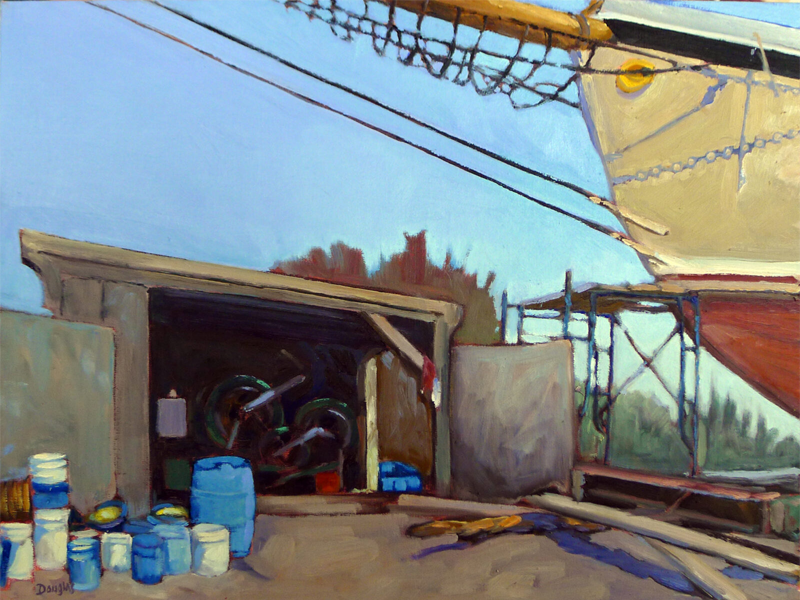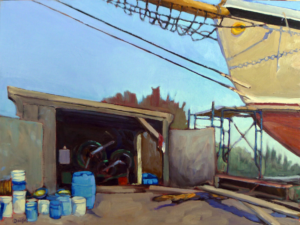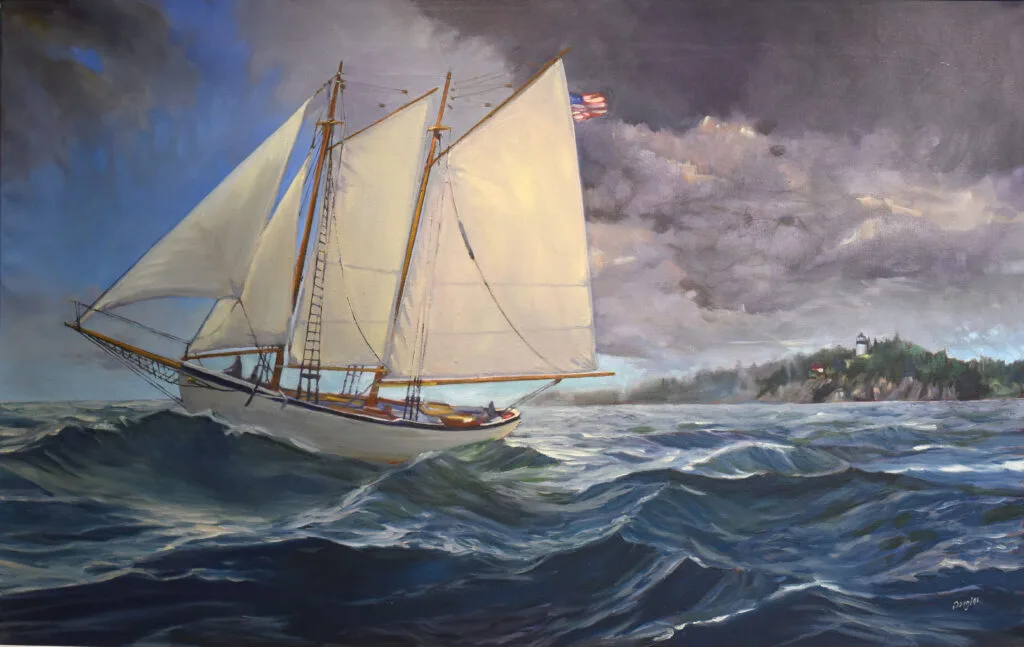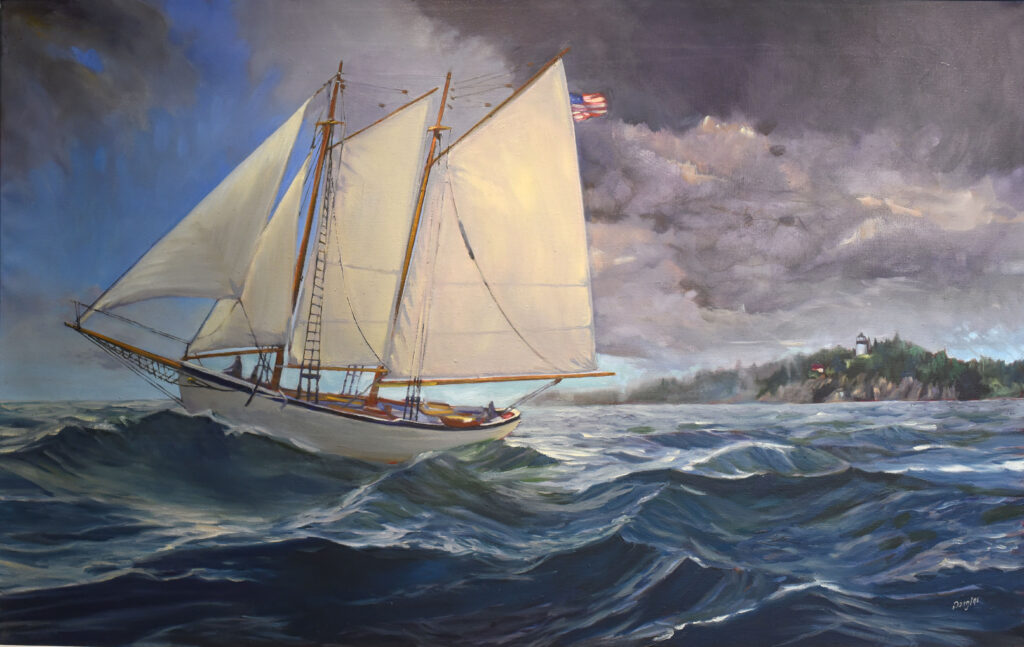Shortly after I moved to Maine, I presented myself at the North End Ship Yard in Rockland to ask if I could paint. It was spring, and the annual rite of fit out was just starting. This is when the windjammers are lifted out of the water, their hulls scraped and painted, and below-the-waterline repairs done. Large wooden vessels spend all year in the water, and each boat spends just a few days on the rails. If they pass their Coast Guard inspections, they are allowed to sail another season.
It was there that I met Captain John Foss of American Eagle, and Captains Doug and Linda Lee of Heritage. They’ve co-owned the shipyard for almost fifty years. They are tolerant of artists and allowed me to mooch around the yard all spring.
When that season ended, Captain John said, “Why don’t you go out with us on our last cruise? You can see what this is all about.” I foolishly brought oil paints, which got all over his beautifully-finished deck, but he’s a very even-tempered fellow.
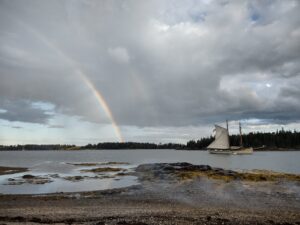
The next year, we started our watercolor workshop, because the paint is easier to get off the fittings.
I think American Eagle is the best-looking schooner in the Maine Windjammer fleet. (The ketch Angelique comes a close second.) I’m not saying that just because I sail on her. Some schooners, like Angelique and Heritage, are modern reproductions of 19th century designs. Others are repurposed 19th century working boats. They tend towards the ruffles and ribbons of the Edwardian age.
In contrast, American Eagle was built in 1931, part of the last generation of the Gloucester schooner fishing fleet. She has an elegant, austere silhouette. I’d almost call her Art Deco, she’s so sleek. The graceful arc of her prow, which is all that shows in American Eagle in Dry Dock, is a hint that the whole of her is equally graceful.
That first fit out impressed me with the amount of sheer, hard graft the captains put in readying their boats for the water. Of course, they don’t do it alone; each year they get a new crop of youngsters working as deckhands or messmates. (If I’d known such a gig existed when I was 18 or 21, my life would have been very different.)
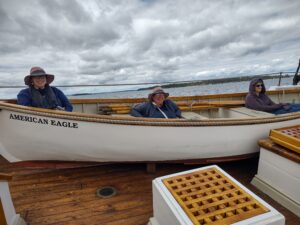
Before they ever go out, these hands scrape, strip, varnish, paint, caulk, lug, climb… in short, any difficult physical labor you can imagine, they do. And the captains are right there with them, even up past an age when any sane person would have retired.
What I didn’t realize was that life on the water is as strenuous as life in the winter. Not only does the crew handle the ship (and there are no labor-saving devices on board), they also prepare meals and serve passengers. They take turns staying awake at night to keep watch, because the schooners anchor in deep water.
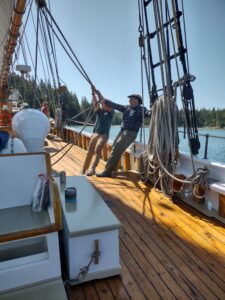
Two years ago, Eagle went out with a new captain, Tyler King, who is the same age as my youngest kid. I’d sailed with him as John’s mate, but that’s different from having all the responsibility for boat, crew and passengers on his young shoulders. On our first cruise together, I watched him do a quick evasive maneuver with utter calm and competence. He’s an excellent sailor and a sharp cookie.
The chances that I can convince my husband I need a sailboat are slim to nil. Realistically, I can’t even take out the skiff I own. But I’m blessed to be able to go cruising during my watercolor workshop, and I don’t have to do any of the heavy lifting.
Remember to bookmark December 1 for our first Virtual First Friday, starting at 7 PM. I think it’s going to be a gas.
My 2024 workshops:
- Painting in Paradise: Rockport, ME, July 8-12, 2024.
- Sea & Sky at Schoodic, August 4-9, 2024.
- Find your authentic voice in plein air: Berkshires, August 12-16, 2024.
- Art and Adventure at Sea: Paint Aboard Schooner American Eagle, September 15-19, 2024.
- Immersive In-Person Workshop: Rockport, ME, October 7-11, 2024.

